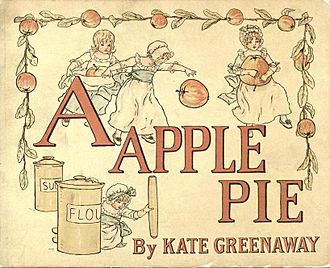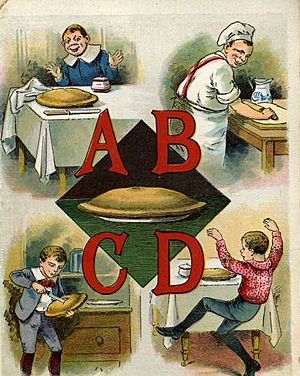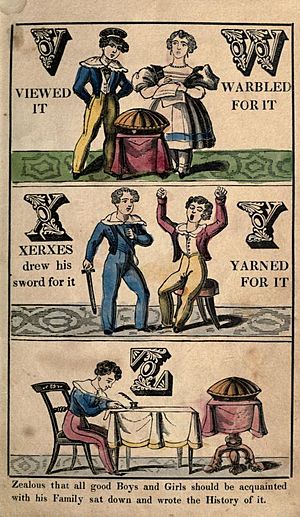Apple Pie ABC facts for kids

Apple Pie ABC is a very old and popular English alphabet rhyme for children. It has been around since the 1600s and has changed quite a bit over time.
Different Versions of the Rhyme
The words of the rhyme started to change in the early 1800s. One version from 1808, called The History of the APPLE PIE, had lines like "B bit it" and "C cried for it." It went through the whole alphabet.
Many different versions of the rhyme were published. A very famous one was Kate Greenaway’s A Apple Pie: An Old-Fashioned Alphabet Book from 1886. This book is still printed today! Kate Greenaway changed the ending to be happier. Instead of wishing for a piece of pie, her version says "UVWXYZ all had a large slice and went off to bed." This allowed her to use fewer pictures.
The rhyme also changed in other ways. For example, The Real History of the Apple Pie had a much longer ending. It described what each letter of the alphabet did with the pie.
- A said, "Give me a good large slice."
- B said, "A little bit, but nice."
- C said, "Cut me a piece of crust."
- D said, "Take it, it’s dry as dust."
Even famous writers made their own versions. In 1871, Edward Lear wrote a funny, silly poem called "A was once an apple pie." It started like the rhyme but then went off into nonsense.
Publishers like McLoughlin Brothers and Raphael Tuck and Sons also made their own Apple Pie ABC books. These often had new verses that were completely different from the original rhyme. For example, one McLoughlin Brothers' book had:
- E stands for Ellen who sat at the table
- And tried to eat more than she really was able.
Even with all these new versions, the original rhyme stayed popular. Many books in the 20th century, like Kate Greenaway's, were still based on the old rhyme. However, the pictures in newer books often showed fantasy creatures instead of just children.
The Rhyme in Other Stories
The "Apple Pie ABC" rhyme was a favorite of the English writer Charles Dickens. He mentioned it in a few of his books.
In an essay called "A Christmas Tree" (1850), Dickens talked about children's books. He wrote about how the letter 'A' could be many things, like an archer or an apple-pie.
In his novel Bleak House (1852), he used the rhyme to describe how complicated legal cases could be. He said that lawyers and courts went "through the whole alphabet, like the history of the apple pie." This meant the process was long and involved everyone from A to Z.
Dickens also mentioned the rhyme in his story "The Italian Prisoner" (1860). He described the trouble of moving a large bottle of wine through Italy. He said different towns reacted to the bottle "like the apple-pie in the child's book." For example, "Parma pouted at it, Modena mocked it, Tuscany tackled it."
These mentions suggest that Dickens knew the "Z" version of the rhyme.
See Also
- Beside the various editions listed in their Dictionary of Nursery Rhymes, there are 19th-century books from the Opies' personal collection, given to the Bodleian Library in Oxford. See pages 1–2 of the catalogue PDF
- The illustrations from Kate Greenaway’s 1886 edition



